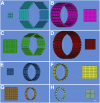Development of Dedicated Brain PET Imaging Devices: Recent Advances and Future Perspectives
- PMID: 31028166
- PMCID: PMC6681695
- DOI: 10.2967/jnumed.118.217901
Development of Dedicated Brain PET Imaging Devices: Recent Advances and Future Perspectives
Abstract
Whole-body PET scanners are not optimized for imaging small structures in the human brain. Several PET devices specifically designed for this task have been proposed either for stand-alone operation or as MR-compatible inserts. The main distinctive features of some of the most recent concepts and their performance characteristics, with a focus on spatial resolution and sensitivity, are reviewed. The trade-offs between the various performance characteristics, desired capabilities, and cost that need to be considered when designing a dedicated brain scanner are presented. Finally, the aspirational goals for future-generation scanners, some of the factors that have contributed to the current status, and how recent advances may affect future developments in dedicated brain PET instrumentation are briefly discussed.
Keywords: PET; high spatial resolution; multimodal imaging; neuroimaging.
© 2019 by the Society of Nuclear Medicine and Molecular Imaging.
Figures






References
-
- Thompson CJ, Yamamoto YL, Meyer E, Positome II: a high efficiency positron imaging device for dynamic brain studies. IEEE Trans Nucl Sci. 1979;26:583–589.
-
- Hoffman EJ, Phelps ME, Huang SC. Performance evaluation of a positron tomograph designed for brain imaging. J Nucl Med. 1983;24:245–257. - PubMed
-
- Freifelder R, Karp JS, Geagan M, Muehllehner G. Design and performance of the HEAD PENN-PET scanner. IEEE Trans Nucl Sci. 1994;41:1436–1440.
Publication types
MeSH terms
Grants and funding
LinkOut - more resources
Full Text Sources
Other Literature Sources
Medical
